Leisure-time physical activity is related to cartilage health and quality health in knee osteoarthritis
Higher leisure-time physical activity (LTPA) level promotes cartilage health in postmenopausal women with mild knee osteoarthritis (OA). This was observed in a study carried out in the Faculty of Sport and Health Sciences at University of Jyväskylä, Finland. This study investigated the relationship between 12-month LTPA level and changes in estimated biochemical composition in tibiofemoral cartilage.
 Seventy-six eligible postmenopausal women aged 60–68 with knee pain and confirmed radiographic osteoarthritis-related changes in the knee joint were enrolled into this follow-up study. Study participants were divided into three groups based on their average monthly LTPA during the 12-month study period: 1) highest, 2) middle, 3) lowest. Most common LTPA during the study period was walking (including Nordic walking), which the highest LTPA group performed on average three hours per week, middle group one and a half hours per week and lowest group one hour per week.
Seventy-six eligible postmenopausal women aged 60–68 with knee pain and confirmed radiographic osteoarthritis-related changes in the knee joint were enrolled into this follow-up study. Study participants were divided into three groups based on their average monthly LTPA during the 12-month study period: 1) highest, 2) middle, 3) lowest. Most common LTPA during the study period was walking (including Nordic walking), which the highest LTPA group performed on average three hours per week, middle group one and a half hours per week and lowest group one hour per week.
The effect of LTPA on knee cartilage biochemical composition was measured by T2 relaxation time and dGEMRIC index, MRI methods specifically designed to measure the biochemical composition of the cartilage.
The effects of intermittent impact and compressive loading during gait to knee cartilage may evoke favorable effects in cartilage such as improved fluid flow and nutrient diffusion. Maintaining cartilage health requires daily physical activity, and when performed regularly, walking and Nordic walking together with other activities of daily living can maintain or even improve the quality of knee articular cartilage, says Doctoral student, physiotherapist Matti Munukka.
Exercise is an important part of osteoarthritis treatment and maintaining cartilage health
Exercise is an important part of OA management and it is recommended to people suffering from OA. The role of multiform exercise can be emphasized especially in the early stages of OA when the cartilage damage is still mild and pain and stiffness do not restrain exercising. Exercise has been shown to have positive effects in alleviating pain and improving both physical function and quality of life.
This study showed that a higher LTPA level was able to produce sufficient stimulus to improve the estimated glycosaminoglycan (GAG) content of tibiofemoral cartilage. The role of GAG in cartilage health is to lubricate joints and surfaces and to maintain viscoelasticity. GAG loss is an early feature of OA. The clinical significance of this study is that a regular and sufficiently high LTPA level can improve knee articular cartilage health and quality.
The results of this study will be published in the series “Medicine and science in sports and exercise”.
Source: University of Jyväskylä
Full bibliographic information:
Physical Activity Is Related with Cartilage Quality in Women with Knee Osteoarthritis. Med Sci Sports Exerc. 2017 Feb 25.




